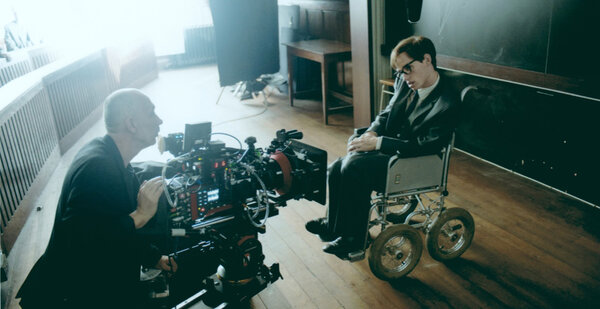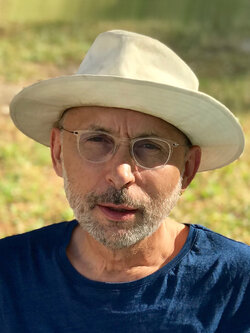Director of photography Benoît Delhomme, AFC, discusses his work on James Marsh’s "The Theory of Everything"
The Theory of Everything : a "biopic" between Douglas Sirk and Kristof Kieslowski
You like going from one genre to another… isn’t that a problem in the USA ?
Benoît Delhomme : It’s true that in the United States, one can quickly get categorized as a cinematographer. After the release of Anton Corbijn’s movie, which was pretty well received in the US, I received ten scripts of CIA-type spy movies, with stories about mosques in England… I turned them all down, but I know that’s the way it works. What I like is more changing genres every time… It’s not a very common approach, because I realize that American and foreign cinematographers are often called on by studios to reproduce the same style of image on every project.
I was able to discuss this recently at a round table event organized by Hollywood Reporter magazine, and it’s totally flagrant. It’s probably a risk that I’m taking not to forge a distinct visual style common to all of my movies, but paradoxically, that’s also the reason why directors like James Marsh come find me !
Did you know him beforehand ?
BD : No… I only knew Man on Wire, his documentary on Philippe Petit’s feat of walking on tightrope between the World Trade Center in August 1974. A film on which James Marsh had done a lot of fictional recreation, something the English and the Americans are very good at doing when they don’t have the facts on hand. When we met, he immediately told me that The Theory of Everything shouldn’t look like an English “kitchen sink drama”.
The original screenplay wasn’t very visual, and the locations were pretty banal… Discussing together, we found a way to anchor the film in a visual style similar to those of Douglas Sirk’s melodramas, with the modernity of a Kieslowski. From a photographic point of view, I could also cite Stephen Shore or Willim Eggleston.
The film is very American in its ambience, despite the fact that it takes place in England…
BD : One of the visual keys of the film relies on Hawking’s character and his research on the cosmos and on light. I wanted the photons to be present on screen, with natural light that was a bit too strong, that bled on to the image and dazzled the indoor shots. That was exactly the opposite of what I did on my previous film with Anton Corbijn. A very particular man, where the colours were muted with no bright lights, and a grey sky most of the time with a leaden autumn feel.
On The Theory of Everything, I wanted the viewer to almost believe that he was in Los Angeles, on a Californian university campus rather than at Cambridge ! For that reason, also, I diffused the image a lot during colour timing in order to create haloes around the whites.
The ball scene, during which Stephen Hawking seduces Jane, is another good example. There is a very gilded feeling around the tents that are set up around the campus, with the fireworks in the background, and the scene lit with blue UV lights that cut the characters out of their surroundings.
For that ball, I asked the production designer to set up as many garlands of tungsten bulbs as he could find around the tents. That gave me a basic amount of lighting on this very vast space and made it easier to capture the many Steadicam shots. Also, a Chinese lantern hung above the actors let me even out the faces.
A word on the camera movements ?
BD : It seemed important to me to let the camera follow Steven’s character as freely as possible in the first part of the movie, so long as he was capable of walking or running. Then, as the illness progressed and he became paralyzed, the movie was constructed much more from prearranged stills.
I also chose to change lenses in order to give a different visual signature to these two periods… the first part was filmed with a Leica Summilux spherical series, while the latter – beginning with the scene in the hospital where he learns of his illness – in anamorphic with old Hawks. Otherwise, I filmed using an Arri Alexa ProRes.
Did you film in chronological order ?
BD : No, for production reasons. That meant an enormous amount of effort on Eddie Redmayne’s part, who had to successively switch between wheelchair scenes and others where he was perfectly healthy. Regarding the lenses, it wasn’t easy to convince the production to rent the spherical series and the anamorphic series for the entire length of filming.
There were also scenes that looked like they were shot with a Super 8, like the Hawking family home movies…
BD : Those scenes weren’t originally planned in the script. It was during preparation that James announced to me that he wanted to include a few “fake” home movies within our film. We immediately thought of a Super 8, which was the format used at that time.
But for production reasons, and especially the time it would have taken to develop and edit those images, we settled on Super 16mm. So, I always had an old Arri 16 on set, and those scenes were improvised depending on the work schedule and James’ inspiration… It was really fun to film, James left me complete freedom with the actors, and we would improvise beach scenes, marriage scenes, and home scenes, keeping with the spirit of home movies.
Those scenes were very warm in the low lights…
BD : Yes, whilst colour timing I chose to put a lot of red in the shadows and yellow in the high lights on the Super 8 images… There was also a development accident with a orange-yellow flare on the marriage, that we kept and were very happy with despite the lab’s most humble apologies ! So, I got inspiration to recreate other “accidents” while colour timing.
On the whole, I didn’t hesitate to have saturated colours on this movie. A few scenes were almost filmed in a primary monochrome, like the scene where Stephen is watching TV that was lit by the sun through bright red curtains. I wanted the colours to give an unexpected energy to this story. Sometimes, I allowed the light to overexpose Stephen’s face. I wanted to create ambiences that told the story of a certain melodrama…but in the sunlight.
Stephen is someone who is incredibly positive. He has no space or time for depression. All the while the illness is running its course and he is gradually losing his mobility and even his own voice, he is almost gaining strength ! We see in the movie that he uses this illness almost as an opportunity to be able to concentrate on what really interested him in life.
Would you tell us a little story from behind-the-scenes ?
BD : The glasses… were pretty funny. A few weeks into filming, the producers suddenly became worried about the omnipresence of glasses. It’s true that Steven Hawking always wore them, and a couple of different pairs are used at different times throughout the narration of the film. Suddenly, this became the subject of meetings upon meetings, on how to manage the reflections and unwanted glare… I had to juggle that a bit, but in the end we were often able to make use of the real reflection of the windows, for example, because it gives life to the image. And then, as soon as the character was in a wheelchair, honestly, the reflection problems became much easier to manage.
(Interview conducted by François Reumont for the AFC)
Synopsis :
England, 1963. Stephen, a brilliant student in cosmology at Cambridge University, intends to come up with a simple and precise answer to the mystery of the universe’s creation. New horizons open for him when he falls in love with Jane Wilde, an art student. But the young man suddenly comes up against a terrible diagnosis : he has a motor neurone disease, better known as Lou Gehrig’s disease, which will paralyze his limbs, his mobility, his speech, and is expected to kill him within two years’ time.
Thanks to Jane’s indefatigable love, courage, and resolution, they begin a new combat as husband and wife in order to resist the inevitable. Jane encourages him to finish his PhD, and as they begin married life together, Stephen, with his PhD in hand, begins research on his most precious possession : time.
While his body is succumbing to the disease, his brain is busy redefining the field of physics. Together, they revolutionize the world of medicine and science, in order to traverse a milestone that surpasses their wildest imaginations : the twenty-first century.
(Translated from French by Alex Raiffe)
 En
En Fr
Fr






